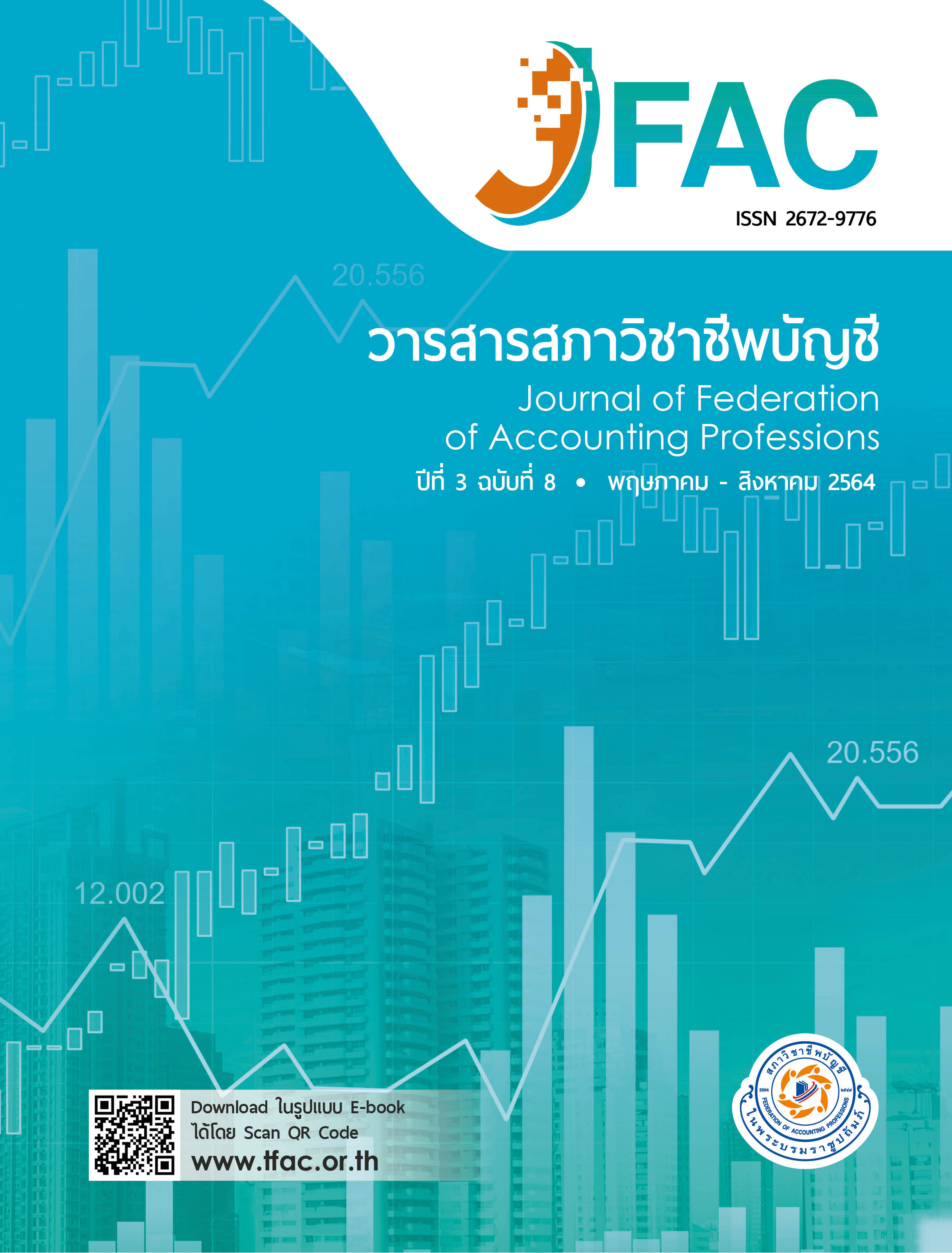RELATIONSHIPS OF FAMILY SHAREHOLDERS STRUCTURE, PROFITABILITY AND LEVERAGE RATIO ON CORPORATE INCOME TAX PLANNING OF THAI LISTED COMPANIES: REAL ESTATE AND CONSTRUCTION INDUSTRY
Main Article Content
Abstract
The objectives of this research were to examine the relationships of shareholder structure, profitability, and capital structure on corporate income tax planning of Thai listed companies in real estate and construction industry except the Real Estate Investment funding and trust. The secondary data was collected during year 2017 to 2019 consisted of 84 companies and 237 firm-year observations from SETSMART online. The statistics used were descriptive and multiple regression analysis. The result revealed that the family shareholder structure had the positive relation on corporate income tax planning, the profitability had negative relation with corporate income tax planning. In addition, capital structure had no significant relation to corporate income tax planning.
Article Details
เนื้อหาและข้อมูลในบทความที่ลงตีพิมพ์ในวารสารสภาวิชาชีพบัญชี ถือเป็นข้อคิดเห็นและความรับผิดชอบของผู้เขียนบทความโดยตรงซึ่งกองบรรณาธิการวารสารไม่จำเป็นต้องเห็นด้วยหรือร่วมรับผิดชอบใด ๆ
บทความ ข้อมูล เนื้อหา รูปภาพ ฯลฯ ที่ได้รับการตีพิมพ์ในวารสารสภาวิชาชีพบัญชี ถือเป็นลิขสิทธิ์ของวารสารสภาวิชาชีพบัญชี หากบุคคลหรือหน่วยงานใดต้องการนำข้อมูลทั้งหมดหรือบางส่วนไปเผยแพร่ต่อหรือเพื่อกระทำการใดๆ จะต้องได้รับอนุญาตเป็นลายลักษณ์อักษรจากวารสารสภาวิชาชีพบัญชี ก่อนเท่านั้น
References
Aksornthue, C., & Sitthikul, K. (2016). The developing of Thailand resident property price index. Stat-Horizon, Statistics and Information Systems Department. Bank of Thailand. Retrieved from https://www.bot.or.th/Thai/Statistics/Articles/Doc_Lib_statisticsHorizon/RPPI.pdf
Boonyawat, K., & Manvapat, S. (2011). An Ownership Structure and the Quality of a Financial Report, Executive Journal, 31(2), 152-158.
Derashid, C., & Zhang, H. (2003). Effective tax rates and the "industrial policy" hypothesis: Evidence from Malaysia. Journal of International Accounting, Auditing and Taxation, Vol.12(1), 45-62(2003).
Hanlon, M., Mills, L. F., & Slemrod, J. B. (2005). An empirical examination of corporate tax noncompliance. Ross School of Business Paper No. 1025. Retrieved from SSRN: https://ssrn.com/abstract=891226 or http://dx.doi.org/10.2139/ssrn.891226
Hoffman, W.H. (1961). The theory of tax planning. The Accounting Review, 36(2), 274 – 281.
Irianto, B. S., Sudibyo, Y. A., & Wafirli, A S. (2017). The influence of profitability, leverage, firm size and capital intensity towards tax avoidance. International Journal of Accounting and Taxation, 5(2), 33-41.
Izadinia, N., Forghi, D., & Gheis, S. S. (2013). The effect of size, return on sales, leverage, fixed assets, industry and ownership on effective tax rate in the listed companies of Tehran Stock Exchange. Interdisciplinary Journal of Contemporary Research in Business, 5(1), 523-527.
Jensen, M. C., & Meckling, W. H. (1976). Theory of the Firm: Managerial behavior, Agency Costs and ownership structure. Journal of Financial Economics, 3(4), 305-360.
Kulthenee, A. (2016). Factors affecting tax planning of listed companies on the Stock Exchange of Thailand: Case study of Service industry. Master of Accountancy and Master of Science, Taxation. University of the Thai Chamber of Commerce.
La Porta, R., Lopez-de-Silanes, F., Shleifer, A., & Vishny, R. (2000). Investor protection and corporate governance. Journal of Financial Economics,.58(1-2), 3-27.
Manurung, A. H. (2019). The influence of liquidity, profitability, intensity inventory, related party debt, and company size to aggressive tax rate. Archives of Business Research, 7(3). 105-115. Retrieved from https://doi.org/10.14738/abr.73.6319.
Modigliani, F., & Miller, H. M. (1958). The cost of capital corporation finance and the theory of investment. The American Economic Review, 48(3), 261-297.
Noor, R. M., Fadzillah, N. S. M., & Mastuki, N. A. (2010). Corporate tax planning: a study on corporate effective tax rate of Malaysian listed companies. International Journal of Trade, Economics and Finance, 1(2). 189-193.
Pearson, E. S. (1932). The test of significance for the correlation coefficient: Some further results. Journal of the American Statistical Association, 27:180, 424–426. DOI: 10.1080/01621459. 1932.10502244
Puji, A. T., Rahmawati, A. Y. A., & Setiawan, D. (2019). The effect of family ownership on Tax avoidance in Indonesia, eJournal of Tax Research, 17(1), 105-117.
Putra, P. D., Zainal, A., Thohiri, R., & Harahap, K. (2019). Factors affecting tax avoidance in Indonesia and Singapore practices: a view from agency theory, Labuan Bulletin of International Business and Finance (LBIBF), 17(2), 24-40.
Richardson, G. & Lanis, R. (2007). Determinants of the variability incorporate effective tax rates and tax reform: Evidence from Australia. Journal of Accounting and Public Policy, 26. 689-704.
Tantiyavarong, T. (2009). A study of the determinants of tax planning and the association between tax planning and firm value: An empirical evidence of Thailand. (Doctoral of Accountancy Dissertation, Chulalongkorn University).
Thanjunpong, S. (2018). The impact of corporate income tax planning on firm value: An empirical evidence from listed companies in Thailand. Journal of Modern Management Science, 11(2), 42-57.


